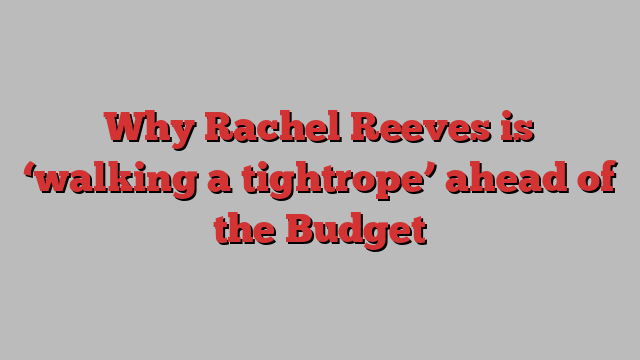
Unlock the Editor’s Digest for free
Roula Khalaf, Editor of the FT, selects her favourite stories in this weekly newsletter.
Chancellor Rachel Reeves is “walking a tightrope”, according to City figures, as she carves out space to borrow billions of pounds extra for capital investment at her Budget on October 30.
Reeves told the Financial Times last week that the theme of the Budget would be “invest, invest, invest” — a message she reinforced when she briefed the cabinet on her thinking on Tuesday.
But can she borrow and invest more without spooking the bond markets and forcing up the government’s borrowing costs?
On Wednesday Reeves will submit “major measures” — her big Budget ideas — to the independent Office for Budget Responsibility, as the watchdog prepares its fiscal forecasts. These are the big issues facing the chancellor:
Why is Reeves looking to change her borrowing rules?
Jeremy Hunt, Reeves’s Tory predecessor, was so tightly constrained by his main fiscal rule — a promise to cut debt as a share of GDP by the fifth year of the forecast — that he announced steep cuts in capital spending. Public sector net investment is due to fall from 2.4 per cent of GDP to 1.7 per cent.
Keeping investment at this year’s level as a share of GDP would imply £24bn of extra annual spending by 2028-29, according to the Institute for Fiscal Studies. That would be a big stretch given Reeves has adopted Hunt’s debt rule.
Reeves’s answer, according to government insiders, will be to redefine “debt” to allow her to borrow more for “productive investment”. But markets are getting jittery about the extent of the extra borrowing this might entail.
Government insiders admit it would be “difficult” to find that extra £24bn. But she told the FT last week: “I don’t want to see big cuts in infrastructure investment.”
How can she reassure the markets?
The big question among investors is how much Budget headroom Reeves creates for herself in her new debt target. Shifting to a metric that better reflects assets, as well as liabilities, could create upwards of £50bn in extra headroom for more borrowing and spending.
The chancellor has sought to allay concerns that she would go too far, telling the FT that she would institute “guardrails” to ensure prudent spending. These could include greater scrutiny by the OBR and the National Audit Office.
She insists she is not in “a race to get money out of the door”, with some people close to her saying she may set out a gradual path towards greater investment spending, given it cannot be delivered overnight.
Another approach would be to opt for a more limited change to the debt target, perhaps opting to strip out the drag from Bank of England losses on its bond-selling programme, creating about £16bn of headroom.
The Treasury could also keep investment vehicles such as the UK Infrastructure Bank or the planned GB Energy off its balance sheet to create further space.
Lord Gus O’Donnell, the former permanent secretary, has suggested an ambitious reform that asks the OBR to assess debt sustainability based on a range of gauges, including public sector net worth and financial liabilities.
How much will taxes go up in the Budget?
By relaxing her debt rule, Reeves could fund tens of billions of pounds of extra capital investment through higher borrowing rather than through extra taxation.
But, crucially, Reeves has a second fiscal rule that she says will be “the real binding constraint at this Budget”: a commitment that day-to-day government spending must be covered by tax revenues.
Reeves told the FT this target would be met within a “maximum” of five years. She could seek to impress the markets with her commitment to control current spending if she met this target more quickly.
She claimed in July to have identified a £22bn “hole” in current spending. About £5.5bn of savings were identified, leaving a remaining gap of about £16.5bn, most of it “recurring” in future years.
Reeves has also vowed to “end Tory austerity”, which government insiders say will mean topping up the budgets of “unprotected” areas, including prisons and local government, which would otherwise be facing real cuts.
Although much depends on growth forecasts by the OBR, Treasury officials are working on a broad assumption that about £20bn will have to be found, from tax rises, welfare savings and other cuts.
What taxes could she raise?
Having announced a £1.5bn cut in winter fuel payments for 10mn pensioners, some earning as little as £13,000, Reeves is under political pressure to increase tax on those — as Prime Minister Sir Keir Starmer put it — with “the broadest shoulders”.
But she has been advised by the Treasury that big tax rises for non-doms and private equity bosses could actually lead to lower tax revenues if they spark an exodus from the UK.
While taxes in both areas are still expected to rise, Reeves says she will not be “ideological” and will not damage the UK as an investment location. Proposed boosts in capital gains tax will be seen through the same prism.
Other options include closing inheritance tax loopholes, making employer pension contributions subject to national insurance and ending the freeze on fuel duty. Reeves is not expected by allies to cut pension tax relief for higher earners, a move that would hit public sector workers.
Senior Tories believe the OBR may help Reeves out by nudging up its growth forecasts in later years, thus reducing the need for tax rises to close the current spending gap.
A crucial risk hanging over the OBR forecast has been the possibility that the watchdog downgrades its assessment of productivity growth, cutting into the growth outlook.